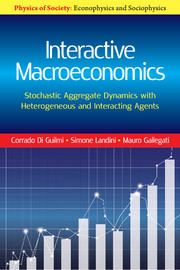6 - Conclusive Remarks
from Part III - Conclusions
Published online by Cambridge University Press: 23 July 2017
Summary
Non siete, non foste e non sarete
nè la prima nè l'ultima
Leporello to Donna Elvira, in “Don Giovanni”
and this is also true for the approach of this book.
This chapter briefly revisits the reasons of this book outlined in the introduction in the light of the tools and applications presented in the previous chapters. Section 6.1 highlights the relevance of the statistical physics (SP) approach for the current macroeconomic theory. Section 6.2 presents some existing developments of this approach and suggests a few possibilities for further applications in macroeconomics.
The Relevance of this Book
Aggregation can be considered as one of the core problems of macroeconomic modelling. The short-cut adopted by mainstream economic theory has led to a misleading approach with the consequences that were made evident by the recent crises. The RA hypothesis, with its necessary corollaries of market order, coordination and agents’ equilibrium, led to a misrepresentation of reality, inspiring improper policy measures. These implications have not been overcome by the introduction of heterogeneity in general equilibrium models. The econometric models adopted by central banks reassure policy makers that after the downturn, the system will return to its optimal growth path, so that the only task of policy makers is to shorten recession periods,
boosting economy with the minimum cost in terms of inflation (given that unemployed workers are just enjoying their spare time, as Lucas (1977) suggested, and do not deserve attention).
Some economists, not being fully satisfied by the simple role of stating that when the storm is past, the ocean is flat again (Keynes, 1924), have investigated different solutions to the aggregation issue that allow macroeconomic theory to be of some utility in the real world. This book follows the approach inspired by SP (statistical physics) and tries to expand it. To this aim, in order to popularize the approach among economists, its mathematical foundations are illustrated, the analytical instruments that are of direct utility in modelling are derived, and the approach enhanced. All in all, the book presents a new framework that can represent an actual alternative to the current mainstream modelling approach.
- Type
- Chapter
- Information
- Interactive MacroeconomicsStochastic Aggregate Dynamics with Heterogeneous and Interacting Agents, pp. 195 - 202Publisher: Cambridge University PressPrint publication year: 2016

